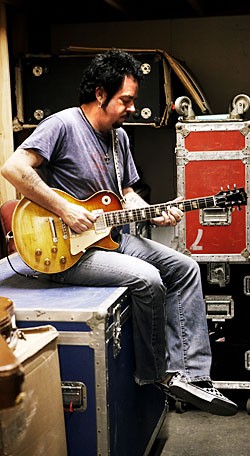
Photo: Rick Gould.
He’s a chops monster – the epitome of taste and understatement. An international pop star and a hard-rocking muso. A gifted songwriter and arranger, in a career spanning more than 30 years he has garnered acclaim as a Grammy-winning craftsman, prestigious record producer, and A-list session player. Just one of those accomplishments would last most a lifetime, but “Luke” is always looking ahead. Bottom line: Steve Lukather is an ultimate survivor of trends and tribulations in the music business. And by the way, he’s one of the finest guitarists to define the instrument in the modern age.
Many aspiring players in the studio traded on the sonic cachet Luke established through his landmark outings with Toto, Paul McCartney, Michael Jackson, Eric Clapton, Chicago, Don Henley, Lionel Ritchie, The Tubes, Cheap Trick, Randy Newman, Stevie Nicks, Boz Scaggs, and others. And they still do – you hear it in well-turned licks that drift ubiquitously from TV commercials, pop and rock songs, film scores, and fusion recordings. Back in the day it was all about tone, technique, time, taste, and touch – and his energy and vibe. After Luke’s emergence, savvy guitarists everywhere scurried to get a handle on his mojo. Throughout the ’80s they scrounged for Floyd Rose-/EMG-equipped Strats, modified Fender, Marshall and Soldano amplifiers, and a host of exotic effects processors in an effort to corner the mystique. At the end of the ay there was still only one Lukather – and the school he set in motion.
Luke built a reputation and following as guitarist extraordinaire with Toto as well as through illustrious studio guest spots, like Lionel Ritchie’s “Running With The Night,” Boz Scaggs’ “Breakdown Dead Ahead,” The Tubes’ “Talk to You Later” and Don Henley’s “Dirty Laundry.” His appearances at The Baked Potato in L.A. picked up where Larry Carlton left off and became required attendance for career guitarists on the scene. By the early ’80s, Lukather’s sound and approach set the standard, and in years that followed he won accolades ranging from gold and platinum records to guitar polls and Grammy awards. He released solo albums, stretched out with the fusion-oriented Los Lobotomies, collaborated as a songwriter on George Benson’s “Turn Your Love Around,” played guitar and bass on Michael Jackson’s multi-platinum Thriller, and was recruited as producer to record Jeff Beck in the ’90s (sadly, a project which was shelved). The new millennium saw Luke touring with Carlton, and releasing the live No Substitutions with his idol.
More recently Luke performed at the prestigious Tokyo Jazz Festival with Herbie Hancock, Wayne Shorter, and “a cast of thousands” in late ’04, including a tour of Japan with Nuno Bettencourt.
Luke returned recently with a new solo album. Ever Changing Times boasts a strong fusion of great songs, well-crafted arrangements and loads of guitar gems. We caught up with Luke for a chat and equipment hang at his gear haven in Hollywood Studio Rentals.
Let’s talk about your guitars.
Obviously, I’m a Music Man guy now, but I have collected some interesting pieces over the years. I could kick myself for selling some of the good old ones, like my 1958 Les Paul Standard goldtop and a ’60 Les Paul Standard sunburst. I sold them for a fortune about five years ago. I never played the ’60 much – the neck was too thin for me; didn’t feel right. I know it’s a bitchin’ guitar and worth a lot, but someone offered me an exorbitant amount of money. I almost didn’t sell the goldtop, but the guy kept upping his offer. I asked myself, “When’s the last time I played this?” and let it go. I kick myself now, but then I came out a billion percent up (laughs), and I still have some prized pieces.
Like your famous Les Paul Standard, the “Rosanna” Les Paul?
Yeah. The holy grail of the collection; it has a lot of history. I wouldn’t give that one up. It’s a ’59 and I bought it when [Toto was] doing the second album. I did that tour with it. I was basically a Les Paul guy at that point; I had the goldtop and it. I also had a sunburst 1971 Les Paul Deluxe with mini-humbuckers, which was the first good guitar I ever had. I got that one from my parents.
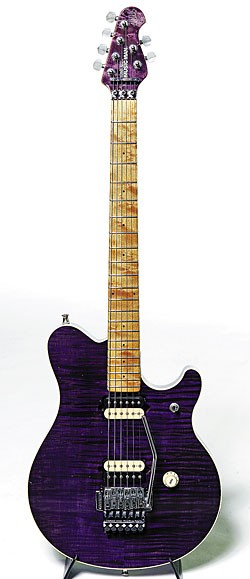
1992 Ernie Ball EVH (3rd one made). Photos: Rick Gould.
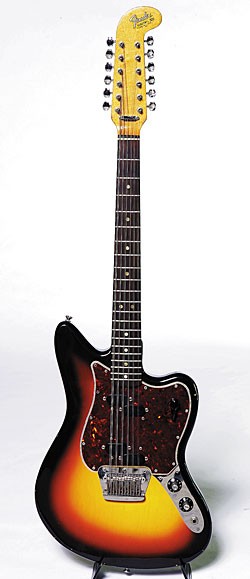
1966 Fender Electric XII.
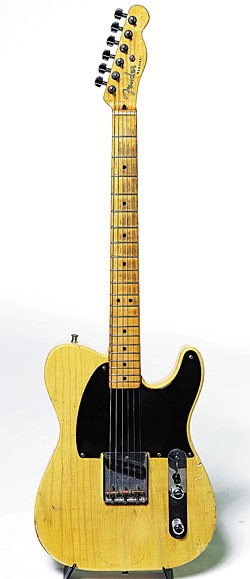
1951 Fender Esquire.
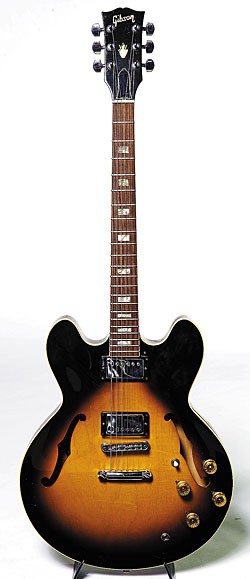
1973 Gibson ES-335TD.
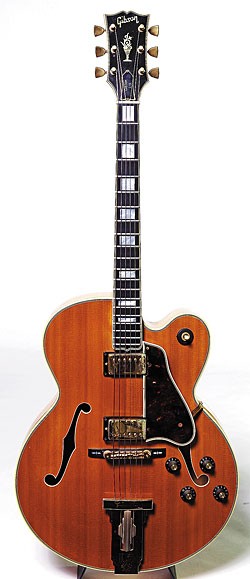
1977 Gibson L-5CES.
Did you use the Les Paul Deluxe on your early sessions and records, like the solo on “Hold the Line”?
Yeah, it was around before I bought the goldtop. The guitars I used on the first Toto album were the Deluxe, my 335, and the number three or four Valley Arts Strat-style guitar. That Valley Arts Strat is now the “Robot guitar.” It used to have a mahogany finish, but I painted it in the ’80s, when it was flash to do that sort of thing.
Did you use the Deluxe for some of those famous solos, like (Boz Scaggs’) “Breakdown Dead Ahead”?
No, that was already the ‘burst. I’d just gotten it. I did Boz’s earlier record, Down Two and Left, with the 335 and the Les Paul Deluxe. That was when I did the tour with Boz, around ’77.
What is the state of things with Toto?
We did a reunion awhile back and have a new DVD, but I’m done with it for now. I’ve got my own thing going. The guys I started the band with are no longer in the band. I was the last man standing; I looked around and thought, “This is a little strange.” They were all great players, but it was time for everyone to move on.
What about some other classic Luke solos done with the ‘burst?
I used it on so many recordings. I did Lionel Ritchie’s “Running with the Night” on that, the riff to “Beat It,”… a lot of hit records. Basically everything from 1980 to ’83 was all the ‘burst. Well, that and the first Valley Arts guitar.
Didn’t you recently play it on a Les Paul tribute?
Yeah, I went to the studio and there was Abe (Laboriel) Junior and Senior, and Kenny Wayne Shepherd – nice kid and great player. We did a couple of tracks, trading solos back and forth; I was playing my Music Man on the basic tracks and brought along my Les Paul – it’s a Les Paul album – I had to play a Les Paul. Then they asked me to do the live concerts in New York at Carnegie Hall, and at the L.A. Amphitheater. I didn’t want to take the ‘burst to New York, so I used a reissue for that. When I played L.A., I used the real one. Everybody else brought their reissues and their own customized versions and signature models – Slash, Frampton, Satriani, Joe Perry, Ace Frehley… I was the only guy who brought a real ‘burst. All my old guitar techs were there – Jerry Sambatino works with Joe Perry now, Matt Bruch. They were babysitting my guitar. Everyone was buzzing, “Wow! That’s a real one!” When I played, it was just a Marshall, a Tube Screamer, and the ‘burst. It filled the room!
In your session days, what amps did you play with the guitar? Any favorite combinations?
I played the ‘burst through Fenders and Marshalls. I had an old blackface Deluxe and some straight-ahead Marshalls from that era – late ’70s.
Did you use any old Marshall “plexi” amps back then, or anything exotic?
No, just stock stuff. A couple were customized slightly, but the mods were just midrange controls and stuff like that. There were guys around in the ’70s – the usual suspects – who modified amps for pro players in L.A.
What about Strat tones?
Strat tones, early on, were from my Valley Arts guitars. It’s funny; as much as I love Stratocasters I never collected them. I have a couple of Fender Strats, but they aren’t anything special. I bought a ’59 that I gave to Bob Bradshaw as a gift for tightening me up. He had his eye on that one. It didn’t have a vibrato; it was locked (hard tail) but had a nice sound.
I kept looking for a real Stratocaster that felt good, but never found the one. I bought and sold Strats over the years; I went through a lot, but nothing ever clicked. Michael Landau has some great Strats. Guys like him got the good ones; they got lucky or knew where to look, did their homework. Mike’s always been a Strat guy; he’s brilliant, one of my favorite players. We’ve known each other since we were 12. He was always the Strat guy and I was into Les Pauls; when we played in bands together, it was the perfect mix. Later, I got into Strat techniques and tones because Jeff Beck is one of my favorite guitar players, not to mention Jimi. How could you not be into that?
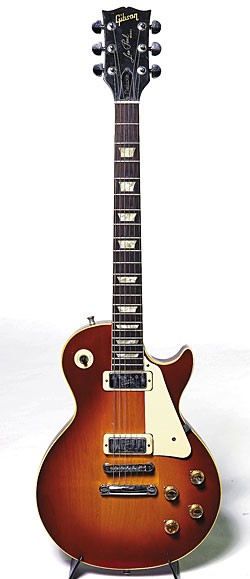
1971 Gibson Les Paul Deluxe. Photos: Rick Gould.
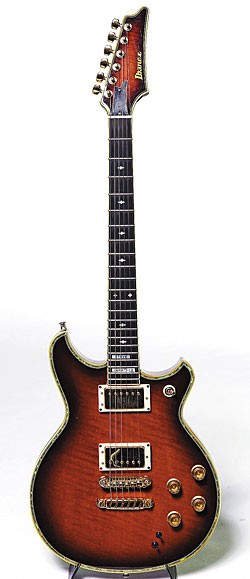
1986 Ibanez Steve Lukather Model.
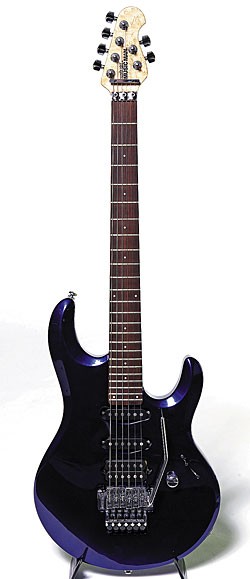
1993 Music Man Steve Lukather Prototype.
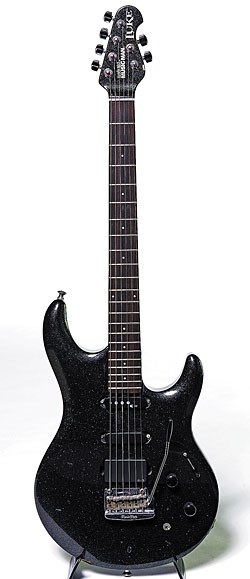
1999 Music Man Luke #1 w/EMGs (black).
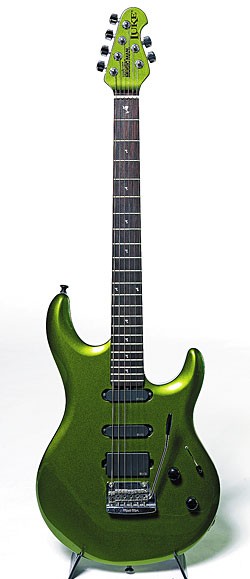
2007 Music Man Luke (Green).
What about the Valley Arts guitars?
I kept two because they have a lot of history. One is the “Robot” guitar, the other is a Cherry Sunburst model with a fancy maple top. They have Floyd Rose systems on them – I was still knee deep in all that. I had the third Floyd ever made, when he was making them in his garage. They have floating bridges – the guitar tech’s nightmare! I’ve always used that setup so I could pull the bar sharp.
When I first got with EMG, we put three active single-coils in the mahogany Valley Arts guitar. I later routed it and put an active humbucker in there – the 85 Vintage model. I just fell in love with that combination: two single-coils and a bridge humbucker. Now they sell it as a set. We eventually moved that concept to Music Man.
What is it you look for in a guitar with that setup?
I go for my Music Man Luke models with EMG pickups. The combination of craftsmanship with those pickups is something I particularly like. Everyone has their favorite flavor. You can’t argue with Stevie Ray, you can’t argue with Jimi, you can’t argue with any legit Strat player; but there’s something about my playing and how the guitar reacts that really works for me. I have all this vintage stuff, but when I say I use Music Man guitars, I really do!
Is it the versatility?
Yeah, they get a lot out of one guitar. And you’re not talking guitars made in Korea or China where you get a good one, you get a lousy one, luck of the draw. These are hand-made instruments made by people in America. Sterling Ball is like family to me, and I’m treated very well. There are only a handful of Music Man endorsees with a signature model – John Petrucci, Steve Morse, Albert Lee… We all make our own noise with it. I’m very honored to be among some of greatest guitar players of all time. There’s a lot of camaraderie when we play together and you can really hear how different we are. I haven’t gotten into the seven-string like John has; I’m still trying to figure out what to do with six (laughs)!
What about the 1951 Esquire?
I got that in the late ’70s, early ’80s. I already had the goldtop and ‘burst, and I began to look into other vintage guitars. The Esquire just fell into my lap; I paid 600 bucks for it. I have to give Paul Jameson some credit there; you know, the legendary “Jamo,” the studio character we all love. He said, “Luke, you’ve got to start collecting these guitars. They’re going to be worth a fortune someday.” He actually hipped me to a lot of stuff. Had I listened more than I did – because I thought paying a couple of grand for a guitar was insane back then – I would’ve bought everything! But like a lot of guys, I’m kicking myself for selling stuff and not buying everything I could get my hands on in every pawn shop in America before everyone got hip to it. Now you can’t find them under grandma’s bed anymore. I should’ve collected more, but I was so busy working.
Did you play the Esquire on many sessions?
I played it a lot on the Toto IV record. Anything that sounds remotely like a Tele is that Esquire. It’s me doing my impression of Keith Richards! I remember working with Waddy Wachtel once and he hipped me to all the Keith stuff – pulling off the low E string, open-G tuning… suddenly every Stone song sounded right (laughs)! I never got into open tunings until later in life. I remember working with Joni Mitchell and she had all these D minor 11th tunings. It was so interesting how her tunings would work with standard-tuning riffs. It was a lovely noise. The unique timbres match and you create a whole new sound.
Did you use your ES-335 a lot before the Les Pauls?
The 335 was my guitar for the first record I ever played on, Boz’s Down Two and Left. I used it for the solo on “Clue,” which a lot of people have said they liked. That’s the 335 with an Orange Squeezer (Dan Armstrong compressor) through a blackface Princeton. That was what the cats were using back then: a 335 with Fender blackfaces and gadgets to make it sound different – like the Boss Chorus when it first came out. Jay Graydon turned me on to that one. They were all using them at the time, Ritenour and all those guys I was sitting next to.
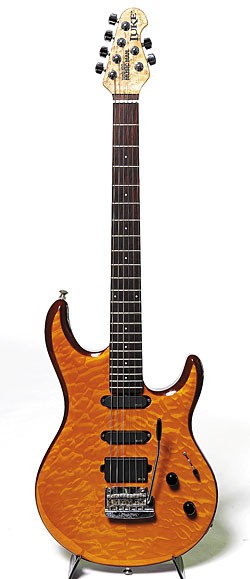
2007 Music Man Luke (quilt top). Photos: Rick Gould.
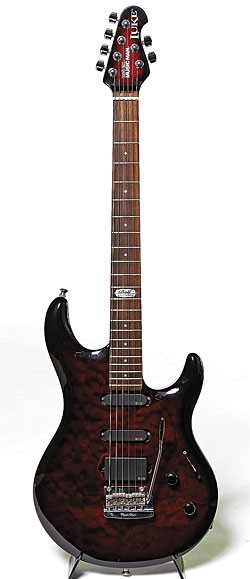
2008 Music Man BFR (Family Reserve).
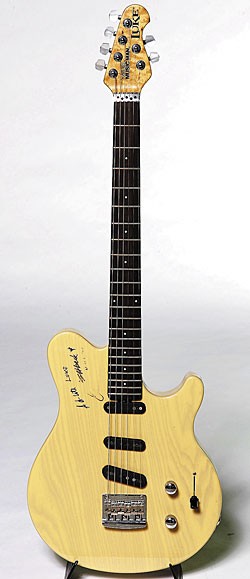
1996 Music Man (Luke neck on EVH body).
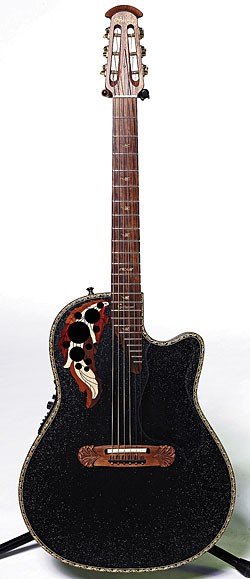
2008 Ovation Adamas.
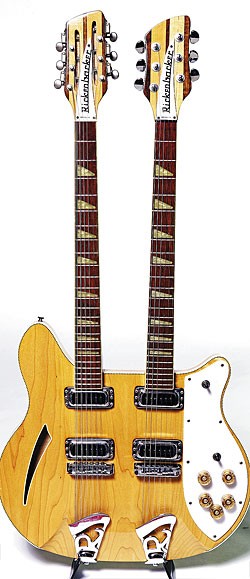
1976 Rickenbacker 12/6 doubleneck.
Do you still have those old effects boxes?
Yeah, I had a couple rebuilt. Bob Bradshaw rebuilt one because sometimes the old stuff gets noisy. It’s cool for live playing, but when you’re recording you can’t have it. But a lot of my old stuff got stolen – old microphones, old guitars, old MXR effects and the like. We had so much gear we didn’t know where it all was.
What are some other highlights of your guitar collection?
I have a 1965 Fender electric 12-string that I got around the time of Toto IV, as well. I bought the most guitars from 1981 through ’85. I have a double-neck Rickenbacker that is such a weird guitar; I just thought it was unique piece. I used it in the studio, but it has never seen a stage; it’d be like tying a Volkswagen around your neck! Even as a young man, it’s too much. And Rickenbackers have that specific sound; you immediately start playing Byrds songs on them!
I have a blond L-5CES I got that as a present from Boz Scaggs backstage at the Greek Theater in LA in ’77. Gibson brought a bunch of guitars down, and I started playing the L-5. I said, “This is neat, something I’d never buy for myself.” Boz saw me and said, “It’s yours, man.” That was very cool; it was the fourth guitar in my collection. I was still living at home with my parents when I was on the road with Boz, saving my tour money to move out.
I have a lot of really weird ones in my collection. The Vigier is a strange guitar; Patrice Vigier gave me that one in Paris around ’81. It looks a little like a BC Rich mixed with an Alembic. There’s also an old Vox 12-string with all the weird effects built-in, like a fuzztone that sounds just like “Satisfaction.” It has the palm wah and a strange tone control and a button for an A440 tone so you can tune – it’s just a really unusual guitar, and it sounds great. That one fell into my lap too; I got it for 250 bucks.
How did the Music Man Luke model come about?
My Valley Arts guitars were custom-made, much like my Music Man guitars are now. Dudley Gimpell builds them for me, and what’s funny is he used to work at Valley Arts with Mike McGuire back in the day! So my transition wasn’t a big change. I didn’t want to stay with Valley Arts when they sold to the Koreans in the ’90s, and Sterling said, “Hey, Dudley’s over here now.” That’s where I got the number-three Eddie (Van Halen Music Man) guitar. They were putting it together and I just happened to be hanging out. They asked which one I liked the best in a blindfold test. I think they were happy with my opinion, but I don’t know if they used it.
I’m good friend with the Ball family – their whole crew. I’ve used Ernie Ball strings forever, and Dudley knows exactly how to build and set up my guitars. I’ve been playing them since 1993.
We tried a few different body styles. There’s a particular neck I like, it’s on the Robot guitar; it feels really good. We took it off and made a computer model with all the little quirks, and then improved upon it. The first one had a Floyd Rose but we eventually phased that out. I mean, who does divebombs anymore? That was unique to the ’80s, when everyone was trying to do their impression of Ed. But that got tired, and now we have a standard non-locking vibrato-bar bridge and nut. And I didn’t want the guitar to have “Lukather” on it. My nickname is “Luke” – nice and short – and we used that. I’m like Cher now (laughs)!
How important are the EMG pickups to your sound?
We tried other pickups in the prototype I used for “Never Walk Alone” on my second solo album, Candyman. That was a really good-sounding guitar but for some reason wasn’t responding like the EMGs. It didn’t have active pickups. I’m a big EMG guy; they’ve been good to me, too. Some people love ’em and some hate ’em, but for me they’re perfect.
There was the myth that they are responsible for the “Lukather sound.”
Listen, I play everybody’s guitars. I’ve been around a lot of great musicians, and when I pick up a person’s guitar I sound like me with their amp and guitar, and visa versa. A great instrument with great pickups is obviously a help, but give someone a half-million-dollar Les Paul it’s not going to make them play any better.
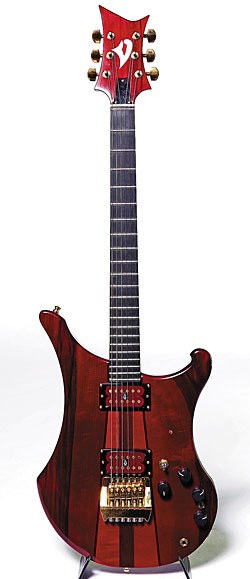
1982 Vigier. Photos: Rick Gould.
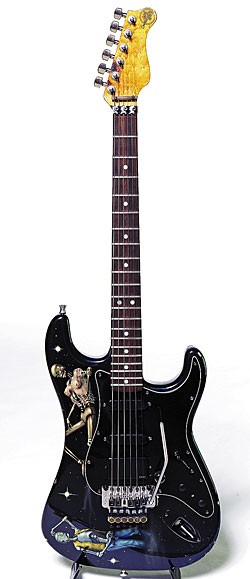
1979 Valley Arts “Robot”.
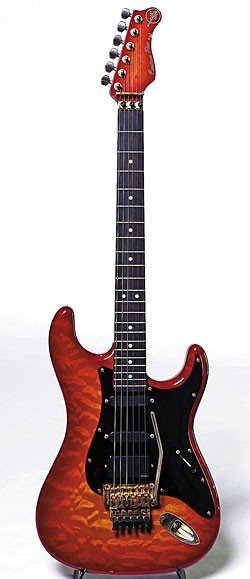
1983 Valley Arts Custom Pro.
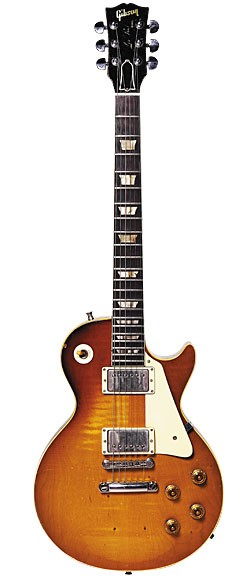
This 1959 Les Paul Standard (serial number 9 0494) was Lukather’s primary guitar during the heydey of Toto. He also used it on high-profile studio sessions in the early 1980s, including the riff to Michael Jackson’s “Beat It,” and Lionel Ritchie’s “Running with the Night.”
Do people still apply that label these days?
I hate that so many blame me for that over-processed guitar sound. I didn’t invent it and wasn’t the first to use all the grease. The producers asked for that sound. What gets me is when I go the NAMM Show and see some new box that has a “Lukather Sound” preset. I press it and it sounds like echo returns with the worst flanger you ever heard – cheese whiz. Is that what people think I sound like?
There is some guilt there, but when that gear was new everyone overused it. To me, the ’80s have not worn well. Listen to ’70s records and they sound good, but when you get to the ’80s, the synthesizers, drum machines, and sequencers came in. And with them, the over-effected, over-processed, tri-chorused, harmonized, reverbed sound. Everything was cheese-whizzed; even the look, with the hair and MTV… It was a sad era for music.
On the new record, you get back to more “honest” gear and music. Tell us about the equipment we’re hearing.
For a lot of it I used my son’s Marshall 2000. He got a good one; I’m always borrowing it. It’s a three-channel amp, but doesn’t have a million knobs like the later ones. I also played through some great little vintage amps from Hollywood Studio Rentals; a 1960 10-watt Supro with EL-84s, a 1963 Magnatone Custom 260, a 1959 Gibson GA-6, and a 1964 Vox AC30 Top Boost. I also used an old Ampeg VT-22, a couple of 50-watt Marshall plexis, and a little John Suhr boutique amp.
I used an ISP subwoofer system, too. I go out of the amp’s second speaker output into the sub. It has a power amp and crossover control; you can dial in just how much low-end you want. You get so much beef and chunkiness for power chords. You mic it with a kick drum mic or something you’d use for a bass amp, and put it on a separate track to have control in the mix. It’s subtle, but it’s huge. Then you add a little tube compression, like from a Neve. The desk we used to mix the record was the same desk they used for Dark Side of the Moon, the Neve at EMI with the original parts and some upgrades. You can’t go wrong with that old technology especially if you use Pro Tools software, which is the standard for recording these days. I like to use the best of the old analog and vintage stuff along with the new technology.
How did the new album come about?
It really started a while ago. I had a great time working with Larry Carlton back in 2001. We won a Grammy for the live record, and Larry was responsible for me getting back to the woodshed. On tour, I got paid to learn guitar from Larry Carlton! Every night, I’d come in an hour early and say, “What’s my lesson today?” He was so gracious and has a wealth of knowledge. He got me thinking “It’s time to take this all seriously.” I went through a period of fusion instrumental music for three or four years, between my stints out with Toto.
Then, Randy Goodrum, my old songwriting partner, told me that a new label wanted me to be their first artist. But they wanted a rock-and-roll record with vocals. I realized I hadn’t done one like that in 10 years, and this might be a good time. They wanted something melodic, for me to sing and write songs – and to play, just not a fusion thing with 20-minute guitar solos. Randy and I got together, and it started to flow. So I called in Steve MacMillan, my co-producer and engineer. He said, “If we’re going to do this, let’s get all the vintage gear out. Leave the other crap at home. Let’s get in there with some really good guys and play.”
I got Abe Laboriel Jr. on drums and Lee Sklar on bass, and Jeff Babko, Steve Weingart, Randy Goodrum and Steve Porcaro on various keyboards. Babko was on the basic tracks, helped me write the charts and co-wrote a song, “How Many Zeros.”
Is that the one with the gospel feel?
Yeah, I wrote that one with Stan Lynch. It has some interesting chord changes, adult chords; I’m not afraid of those (laughs)! With the songwriting process, I just wanted to write songs I liked. I didn’t try to write a hit single. I’m 50 years old. Do you think Top 40 radio is going to jump on my new record?
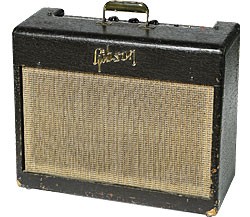
20) 1959 Gibson GA-6. Photos: Rick Gould.
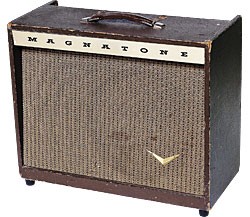
1950 Magnatone Model 213.
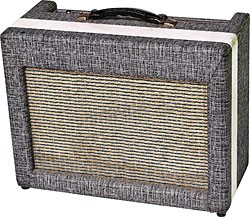
1966 Supro 1620T.
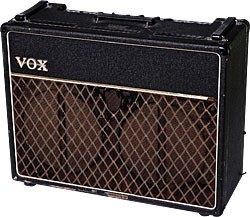
1964 Vox AC30TB.
Was there a no-frills approach to composing and recording?
When Randy came into town, we wrote songs with an acoustic guitar, a little teeny keyboard and little tape recorder in a room at the Howard Johnson’s on Vineland Boulevard. If it worked there, we knew it would work in the studio when the guys added their sheen, improvisation, and ideas for arrangements and licks. Randy and I wrote most of the record. I wrote two with my son, Trevor, which he played on. “Tell Me What You Want From Me” – that’s him playing all the heavy riffs. That one’s my Pink-Floyd-meets-modern-rock song. I used my influences shamelessly; I have my Steely Dan tribute, which is “Stab in the Back.” The closer it got to sounding Steely, the more I went with it, with the acoustic guitars, the talk box – let’s do a little “Haitian Divorce.” It went through all their eras. It’s my audition for Donald and Walter; I’ve been teasing them for years that I never got to play on a Steely record. I just wanted to write for fun; I didn’t care if the songs sounded a little like this or that. But I didn’t steal from anyone; I even thanked Donald and Walter on the liner notes.
We cut the basic tracks live – old-school. The guys are so good it only took a couple of passes. We just wrote out some chord sketches, essential stuff; everything else was open. I never rehearse for a record; you rehearse the spontaneity right out of the music! You rehearse for a tour, not a record.
Basically, I went in with some great players and had a great time. Steve MacMillan pushed me hard with the vintage gear. And Trevor would come down and give me flak, like “Dad, you can do a better solo than that.”
Did you have any revelations with the vintage gear?
I wanted the music to say, “Hey, it’s Luke again. Remember me? This is me plugged into an amp. I’m not using all that grease anymore.” There was nothing between the amp and me. I wanted the sound to be as organic as possible. We just used a little room sound and maybe some slap echo in spots. I used the tremolo on that Magnatone amp; it almost sounds like chorus. Some of the stuff that sounds chorused is actually double-tracked and de-tuned; that’s done with pitch-change speed alterations, an organic true chorus, not a pedal. The little Gibson amp really surprised me; it had such a great breakup, also the AC30s. All those old amps have a ring to them. When you play chords on the verge of distortion, and double it… that’s a wonderful sound.
I had these amps, 10 or 11 of them, set up in the room and listened to all of them. Radial sent me an amp switcher I used to step through different combinations. “Let’s hear the Gibson and the Supro, the Vox, the Ampeg”… I was able to audition different tones for the tracks. I work really fast, so I didn’t document every detail. I have to give a lot of credit to Steve MacMillan; he really knows how to capture the sound with a mic. We used vintage mics and vintage mic preamps with the vintage guitar amps.
I used all the internal effects on the Vox 12-string, like the fuzz for some key licks. And I used a real talk box in “Stab in the Back.” I haven’t messed with one in 30 years. I used the Gibson amp on that track.
Guitarists will be interested in the instrumental “The Truth.”
That’s just Steve Porcaro and me. I wrote the song on piano; it was intended as an instrumental from the beginning. I had the piece lying around for a couple of years but never found a home for it. To me it was like the end-title theme for a movie, and an interesting way to end the record. I asked Steve to over-orchestrate it, then I played the solo guitar part in one pass, all with the fingers – no pick. And I was manipulating the tone controls on the Luke guitar and put a little slap on it. Obviously, it’s a nod to Jeff Beck, my favorite guitar player.
Another nod is the Jeff Beck-Jan Hammer guitar-keyboard trading in “Ice Bound.”
That was Steve Weingart; he’s going on the road with me. Steve’s brilliant, from the Joe Zawinul school. That was a slight reference to the fusion aspect of my style. It seemed natural; Steve and I went on the road with a band called El Grupo, a jam band. We (traded solos) all night long. His playing and phrasing inspire me to play different things. I’m sure I’ll be really inspired by the live band too. I’m going out with Tony Spinner from the old Toto band on guitars and vocals, Steve on keyboards, Carlitos “8 by 10” Del Puerta on bass and vocals, and Eric Valentine (T-Ride, Joe Satriani) on drums and vocals.
This article originally appeared in VG‘s September 2008 issue. All copyrights are by the author and Vintage Guitar magazine. Unauthorized replication or use is strictly prohibited.
Steve Lukather Emotive Soloing



